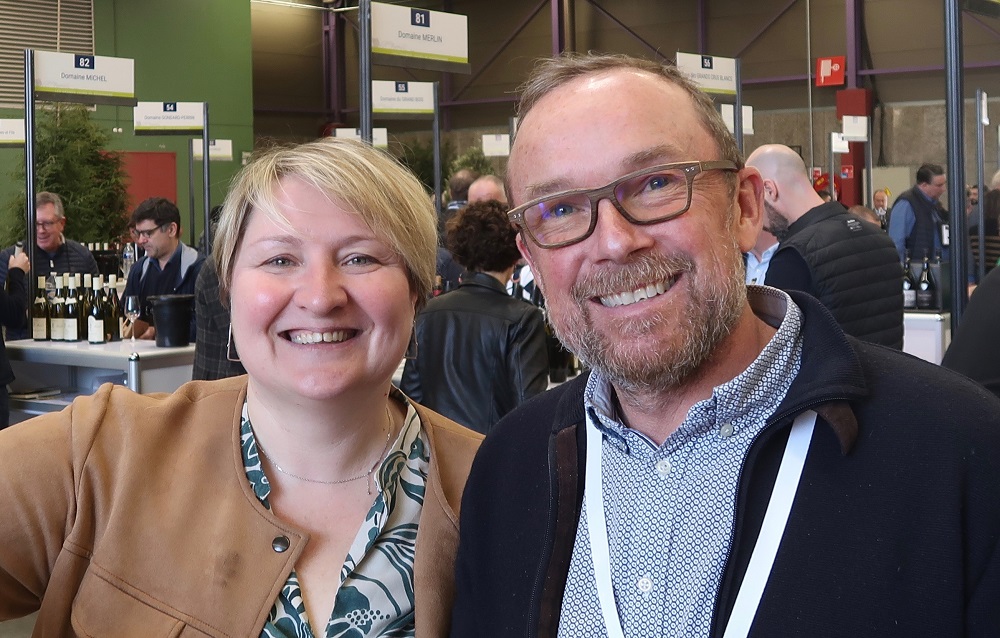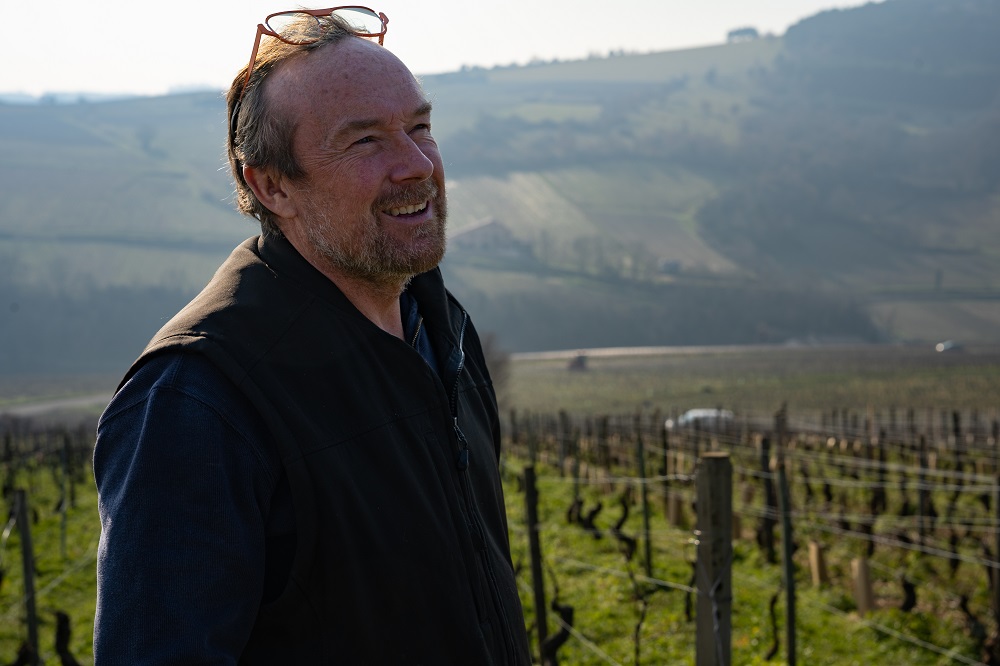Domaine Sylvaine & Alain Normand, Mâconnais

| Country & Region | France, Burgundy |
| Appellation(s) | Mâcon La Roche-Vineuse and Pouilly-Fuissé |
| Producer | Alain and Sylvaine Normand |
| Founded | 1993 |
| Website | www.domaine-normand.com/en/ |
Le style des vins est sérieux et précis et nous suivrons cette évolution avec beaucoup d’intérêt. (The style of the wines is serious and precise and we will follow this evolution with a lot of interest.)
—Guide des Vins 2019, Bettane & Desseauve
Alain Normand hails from the Loire Valley, but his ancestral home is Normandy, hence his name. That makes him a Norseman—a Viking—and true to form he is a tall, red-headed man. The hair was redder and fuller when we met in the last century, but Alain, like his wines, ages gracefully.
He met Sylvaine, a Burgundian, in the wine school in Beaune. They began their careers in the early 1990s by taking over an abandoned vineyard in La Roche-Vineuse with a métayage, or sharecropping contract on 32 acres, a common agricultural practice in France. Vinifications were done in an old stone barn overtop of a hodgepodge of cellars where they aged their wine, just down the road in the village. La Roche Vineuse sits on the flank of a huge limestone outcropping that gives its name to Vineuse. The village overlooks a small pass that cuts through the Mâcon ridges and leads to Cluny, where the Benedictine order of monks had their seat of power in their medieval heyday.

From the very first, Alain has made wine as naturally as possible, relying on spontaneous ferments and long, gentle élevages on the lees. Whereas the local co-ops typically start bottling in January after the harvest, Alain lets his ferments dictate timing, and sometimes the ambient yeast takes till August or even beyond to finish their work. Normally, his classical range of whites is raised in steel while the old vine cuvées are raised in barrel (these days the grapes for the former are harvested by machine while the old vine grapes destined for barrel are hand-harvested). He rarely fines and often doesn’t filter. The vines now cover 86 acres and include appellation Bourgogne, Mâcon, Saint Véran, and Pouilly-Fuissé. The couple has been progressively moving to an organic viticulture and expect full certification in 2024.

In 2009, Sylvaine inherited her family vines. Most were in Solutré, some in Chaintré, and in the years that followed the couple slowly reclaimed these parcels (many had been leased to others) and incorporated them into their production. Their affordable little winemaking barn, however, grew evermore impractical. In 2017, they moved into a modern winery they had built just outside of La Roche-Vineuse, a production facility devoid of any artisanal aesthetic. But it made life a lot easier.

With the 2020 vintage the appellation of Pouilly-Fuissé inaugurated a premier cru classification that was ten years in the making, granting 22 sites spread among Chaintré, Fuissé, Solutré-Pouilly and Vergisson the designation. Among Sylvaine’s inheritance was a 2.5-acre parcel of old vines in Solutré’s Au Vignerais lieu-dit, which gained premier cru status.
In 2023, their son Thomas joined them on the domaine, having done his enology studies at the viticultural school in Beaune—the same school where Sylvaine and Alain had done their studies exactly 30 years earlier.
Thanks to Evan Hansen of the Selden Standard in Detroit for the shot of Alain.
The Wines
| Wine | Blend | Description |
|---|---|---|
| Bourgogne Chardonnay | Chardonnay | The new cellar allowed Alain to both make more wine and to age it properly (in the old days, a lot of what he made was sold off quickly to the négoce). The biggest benefactor has been this cuvée, his “base” wine from parcels in Chaintré and Igé, which could be labeled Mâcon Chaintré or Mâcon Igé or, simply, Mâcon-Villages, but which they bottle as Bourgogne Chardonnay to make a clear break with their Mâcon La Roche-Vineuse cuvées. This wine sees a full 12 months aging in tank on its lees. Production averages 2,000 cases. |
| Mâcon La Roche-Vineuse | Chardonnay | From just over 20 acres on the flanks of La Roche-Vineuse. This is Alain’s original cuvée, and is still made the same way: diligent farming, spontaneous ferments, and a long aging on the lees (that spicy zesty quality in the finish of the wine comes from the lees contact). The bottling is usually in the summer following the harvest, but can wait until the autumn if the wine isn’t ready. Production varies between 4,000 to 5,000 cases. |
| Mâcon La Roche-Vineuse Vieilles Vignes | Chardonnay | This comes from over 8 acres of vines planted in the 1940s following the war, all hand-harvested. The wine is made in barrels that range from one to six years old, with a small percentage being new, and normally is bottled without fining or filtration. The élevage can be extensive, with the yeast sometimes taking up to two years to finish its job. Production averages close to 2,000 cases. |
| Pouilly-Fuissé | Chardonnay | This comes from parcels in Chaintré (roughly 70%) and Solutré (roughly 30% from young vines) and is raised entirely in steel. It’s consistently a full-bodied, rich wine underpinned with good tension. Production averages 800 cases in normal years. |
| Pouilly-Fuissé Climats | Chardonnay | First made in 2019, the year before the premier cru system went into effect. This comes from their Solutré parcels not classified as premier cru—4 parcels, totaling just under 2 acres, hand-harvested and yielding an average of 45hl/ha and aged in barrel, most of which is older. Production averages 350 cases. |
| Pouilly-Fuissé 1er Cru Au Vignerais | Chardonnay | Two and a half acres in Solutré, mostly planted in 1930, hand-harvested and raised 12 months in barrel, some 80% new, followed by 6 months in steel. Maximum production is 325 cases. |